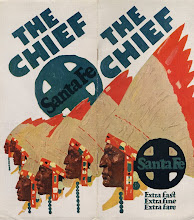Although the library does not presently have the trained staff or resources to undertake aggressive conservation treatments of some of the fragile and brittle works in the collection, we have been actively moving forward with a collection stabilization program. Given our location in the subtropics, donations and new acquisitions are screened for evidence of bookworm and silverfish activity. Suspect items are isolated and frozen in a special low-temp freezer at our off-site annex to prevent the possible transfer of insect infestations to the library. Library interns and volunteers have also been trained to create archival-quality, custom-fit Melinex sleeves for the delicate ephemera in the library collection using an ultrasonic polyester encapsulation machine put together on the premises by inventor William Minter a couple of years ago. This rather expensive machine—(partially funded by a generous Capital Development grant from Miami Dade County’s Department of Cultural Affairs)--has allowed us to produce inexpensive enclosures that provide brittle items with added tensile strength and protect them from the oils naturally found on our fingers. We have also recently ordered archival drop front storage boxes in order to re-house and better preserve the thousands of cruise ship industry promotional materials recently added to our collection by the donation of Dr. Laurence Miller.
Thursday, December 10, 2009
COLLECTIONS CARE AND PREVENTIVE CONSERVATION ASSESSMENT
This Wednesday, the Wolfsonian-FIU Library closed to the public so that rare books cataloguer Dr. Harsanyi and I could join other museum staff in attending an all-day, in-house session with two conservators visiting from the Williamstown Art Conservation Center. The visit, funded by an IMLS grant, allowed the Wolfsonian to bring Leslie Paisley, Senior Conservator for Works on Paper and Adam Nesbit, Assistant Objects Conservator down from the frigid temperatures and snowstorms of New England to South Beach to help us assess and address our present and future conservation needs. They have spent much of their visit this week walking through the museum facilities and storage spaces, and interviewing senior staff about museum environmental concerns, conservation and stabilization policies and practices, and other issues relating to the care, handling, and storage of rare and fragile materials in the collection. Yesterday’s meeting provided museum staff with a bibliography of printed and online conservation resources; samples of materials useful for archival storage; and many useful suggestions for handling, re-housing, and storing rare materials so as to minimize risk of damage and to prolong their life as objects of study.
It is our hope that the conservation assessment made by Leslie and Adam will provide the museum staff with a better sense of what we are doing right, and in what directions we need to go to continue to preserve this important patrimony of the state of Florida.
Subscribe to:
Post Comments (Atom)




No comments:
Post a Comment